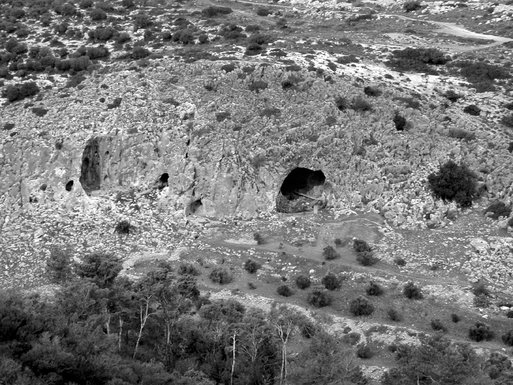|
Other Archaeological Sites / The Neolithic of the Levant (500 Page Book Online) Mesolithic Hayonim Cave The Neolithic of the Levant (1978) by A.M.T. Moore [Oxford University] MESOLITHIC 1 SETTLEMENT PATTERNS The people of Mesolithic 1 used both rock shelters and open stations as habitation sites. The shelter sites, among them Ksar Akil - Jiita II - Hayonim - Kebara - Wadi Madamagh were frequently situated in wadis on the fringes of the hill country ... MESOLITHIC 1 ECONOMY AND SOCIETY At Hayonim the faunal sample was small ..... Gazelle was the most numerous species (See 129ff in Page *1) with fallow deer second. Cattle - red deer - caprines were present in small quantities as well as numerous other species of rodents and carnivores. Hares were very common and it appears that terrestrial molluscs were also eaten. Marine shells have been found at a number of inland Mesolithic 1 sites and also nearer the sea at Hayonim (See Page 137 in *1). Many of these were decorative objects brought up from the Mediterranean but some were edible species. It seems likely that fish and molluscs would have been eaten if only in small quantities where they were available. Most Mesolithic 1 sites have very thin occupation deposits indicating that they were occupied briefly perhaps on a seasonal basis. The presence of amphibian species but not reptiles in the fauna from Hayonim may be taken as evidence that the cave was too wet in the winter for human occupation (See Page 138 in *1); it was probably only inhabited during the summer ... MESOLITHIC 2 Archaeological evidence from sites in Palestine and on the Lebanese coast suggests that Mesolithic 2 developed directly from Mesolithic 1. At Kebara - Nahal Oren - Hayonim - Jiita II the Mesolithic 2 layers were stratified immediately above those of Mesolithic 1 without any serious break in the sequence. There were also enough similarities in the cultural equipment of the two stages from these and other sites to indicate that Mesolithic 2 developed directly from Mesolithic 1 at least in these regions ... MESOLITHIC 2 SETTLEMENT PATTERNS One new feature of shelter sites used by the people of Mesolithic 2 was that the area of concentrated occupation was frequently on the terrace in front rather then in the shelter itself. This was so at Mugharet Wad - Nahal Oren - Qornet Rharra and probably Hayonim. Most of the larger Mesolithic 2 sites were situated in the foothills of the upland zones near permanent sources of water. Some of these like Hayonim - Nahal Oren - Mugharet Wad - Shukbah (Natufian Culture) were in wadis ... MESOLITHIC ECONOMY AND SOCIETY At Hayonim the area of the terrace and shelter was somewhat more than 1000 square metres (See Page 49 in *2) ..... The big Mesolithic 2 sites found in the southern Levant were a significant new group. They appear to have been inhabited by larger communities of people than before. Furthermore the occupation of these sites was more intensive and longer-term: the numerous species of mollusca and human commensals found in the Natufian layers at Hayonim are evidence for this (See Pages 135 and 138 in *1) ..... A recent study of the numerous human remains from Hayonim has shown that they probably all belonged to the same family (See Page 70 in *3). These individuals were buried at intervals throughout the period in which the Natufian deposit accumulated indicating long-term use of the site by at least one family. These large settlements were unknown before Mesolithic 2 ... Natufian Remains in Hayonim Cave by Ofer Bar-Yosef and Naama Goren in Paléorient (1973) Hayonim Cave, situated in the western hilly flanks of the Galilee on the left bank of a small tributary of Nahal Yassaf, today lies 250 metres above sea level, about 13 km east of the sea shore. The prevailing climate is Mediterranean while vegetation includes Ceratonia-Pistacia Maquis 1 and precipitation averages 500-600 mm annually. Excavations, begun in 1965, were conducted in a section of one of the four chambers of the cave. Remnants of two of the chambers which collapsed in antiquity occur with brecciated cave deposits.
ABSTRACT
(1) Archaeological Finds and the Fossil Faunas of the Natufian and Microlithic Industries at Hayonim Cave
(2) Natufian Remains in Hayonim Cave by Ofer Bar-Yosef and Naama Goren in Paléorient (1973)
(3) Family Burials at Hayonim by P. Smith in Paleorient Volume 1 (Pages 69-71) 1973
|
